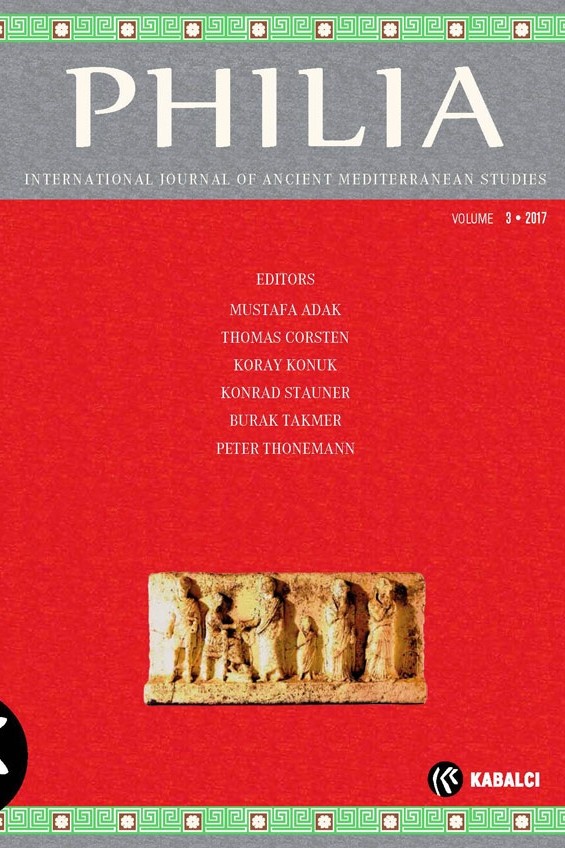Phrygia’da bir İmparator Azatlısı’nın Adak Yazıtı
Yazar makalesinde bir imparator azatlısı olan Flavius Helius
ve eşi Sextilia Hedone tarafından Zeus Bennios’a sunulan ve birbirlerine büyük
oranda benzeyen iki adak yazıtı aracılığıyla Helius’un resmi unvanı olan eirenophylaks
τῆς ἐπαρχείας’ı yorumlamaktadır. Görevleri genel
olarak Roma hukukunu uygulamak ve düzeni sağlamak olan eirenophylaks’lar, bir
eyalet procurator’unun altında görev yapmakta ve ofisleri conventus merkezi
olan bir kentte yer almaktaydı. Yazıtların kazındığı stellerin 2.85 m yüksekliği
ve özenli işciliğiyle, Phrygia Bölgesi’ndeki pek çok kutsal alanda ele geçen
gösterişsiz ve sade stellerden ayrıldığını, şekil ve büyüklük bakımından daha
çok Hermos Vadisi’nde üretilen mezar ve adak stellerine benzediğini vurgulayan
yazar, bu doğrultuda Helius’un çalışma ofisinin daha önceki görüşün aksine
Synnada’da değil Hermos Vadisi içinde, Sardis ya da daha az olasılıkla Aizanoi conventus
merkezinde olabileceğini önermektedir. Yazıtların çevirileri ise aşağıdaki
gibidir: 1) Vespasianus Caesar 9. kez, Titus Caesar ise 7. kez
konsülken, Vespasianus Caesar’ın azatlısı, eyaletin eirenophylaks’ı Agrostea (Köyü’nden)
Timaios torunu Glykon oğlu Titus Flavius Helius, Augustus’lar, kendisi, eşi
Publius kızı Sextilia Hedone ve oğlu Titus Flavius Sextilianus Helius için
kendi vatanı Agrostea ve Zboura’nın Zeus Bennios’una ve geleneksel tanrılara
adağı sundu.
2)
Vespasianus Caesar 9. kez, Titus Caesar ise 7. kez konsülken, Publius kızı
Sextilia Hedone, Augustus’lar, kendisi, eyaletin eirenophylaks’ı, Agrostea
(köyünden) Timaios torunu Glykon oğlu olan kocası Titus Flavius Helius ve oğlu
Titus Flavius Sextilianus Helius için kendi vatanı Agrostea ve Zboura’nın Zeus
Bennios’una ve geleneksel tanrılara adağı sundu.
Anahtar Kelimeler:
Phrygia, Zeus Bennios, Flavius Helius, İmparator azatlısı, eirenophylaks
An Imperial Freedman’s Dedication in Phrygia
Although
members of the imperial familia lived within the Greek communities of Asia
primarily to administer and enforce Roman law, the surviving epigraphic
evidence for their presence mainly relates to their interaction with local
society. The dedications made to Zeus Bennios by Flavius Helius and his wife
preserve substantial information about their cultural and religious
connections. The interpretation of Helius’ official designation, eirenophylax τῆς ἐπαρχείας, is aided by consideration
of the shape and decoration of the stelai on which the texts were engraved.
Keywords:
Phrygia, Zeus Bennios, Flavius Helius, imperial freedman, eirenophylax,
___
- Brélaz 2005 C. Brélaz, La sécurité publique en Asie Mineure sous le Principat (Ier-IIIème s. ap. J.-C.): Institutions municipales et institutions impériales dans l’Orient romain, Basel 2005.
- Broux – Clarysse 2009 Y. Broux – W. Clarysse, Two Greek Funerary Stelae from Lydia and the Antonine Plague, Tyche 24, 2009, 27–33.
- Burton 1975 G. P. Burton, Proconsuls, Assizes and the Administration of Justice under the Empire, JRS 65, 1975, 92–106.
- Burton 2000 G. P. Burton, The Resolution of Territorial Disputes in the Provinces of the Roman Empire, Chiron 30, 2000, 195–215.
- Burton 2001 G. P. Burton, The imperial state and its impact on the role and status of local magistrates and councillors in the provinces of the empire, in: L. de Blois (ed.), Administration, Prosopography and Appointment Policies in the Roman Empire, Amsterdam 2001, 202–214.
- Burton 2002 G. P. Burton, The Roman Imperial State (A.D. 14–235): Evidence and Reality, Chiron 32, 2002, 249–280.
- Dignas 2002 B. Dignas, Economy of the Sacred in Hellenistic and Roman Asia Minor, Oxford 2002.
- Drew-Bear – Naour 1990 Th. Drew-Bear - Chr. Naour, Divinites de Phrygie, ANRW II 18.3, Berlin 1990, 1907–2044.
- Drew-Bear et al. 1999 Th. Drew-Bear – Chr. M. Thomas – M. Yıldızturan, Phrygian Votive Steles, Ankara 1999 (Turkish Republic, Ministry of Culture, Museum of Anatolian Civilizations).
- Herrmann – Malay 2007 P. Herrmann – H. Malay, New Documents from Lydia, Vienna 2007.
- Kantor 2013 G. Kantor, Law in Roman Phrygia: rules and jurisdictions, in: P. Thone¬mann (ed.), Roman Phrygia. Culture and Society, Cambridge 2013, 143–167.
- Kearsley 2001 R. A. Kearsley, Greeks and Romans in Imperial Asia. Mixed Language In¬scrip¬tions and Linguistic Evidence for Cultural Interaction until the end of AD III, Bonn 2001 (Inschriften aus Kleinasien der griechische Städte, vol. 59).
- Lehmler – Wörrle 2006 C. Lehmler – M. Wörrle, Neue Inschriftenfunde aus Aizanoi IV: Aizanitica Minora II, Chiron 36, 2006, 45–111.
- Malay – Gül 1981 H. Malay – Y. Gül, New Inscriptions from Saittai, ZPE 44, 1981, 81–90.
- MAMA IX B. Levick – S. Mitchell – J. Potter – M. Waelkens, Monumenta Asiae Minoris Antiqua IX: Monuments from the Aezanitis, London 1988.
- MAMA X B. Levick – S. Mitchell – J. Potter – M. Waelkens, Monumenta Asiae Minoris Antiqua X: Monuments from Appia and the Upper Tembris Valley, Cotiaeum, Cadi, Synaus, Ancyra Sidera and Tiberiopolis, London 1993.
- Mitchell 1993 S. Mitchell, Anatolia: Land, Men, and Gods in Asia Minor, Volume I: The Celts in Anatolia and the Impact of Roman Rule, Oxford 1993.
- Mitchell 1999 S. Mitchell, The Administration of Roman Asia from 133 BC to AD 250, in: W. Eck – E. Müller-Luckner (eds.), Lokale Autonomie und römische Ordnungsmacht in den kaiserzeitlichen Provinzen vom 1. bis 3 Jahrhundert, Munich 1999, 17–46.
- Naour 1981 Chr. Naour, Inscriptions du Moyen Hermos, ZPE 44, 1981, 11–44.
- Rheidt 2010 K. Rheidt (ed.), Aizanoi und Anatolien. Neue Entdeckungen zur Geschichte und Archäologie im Hochland des westlichen Kleinasien, Mainz 2010.
- Thonemann 2013 P. Thonemann, Phrygia: An Anarchist History, 950 BC – AD 100, in: P. Thonemann (ed.), Roman Phrygia. Culture and Society, Cambridge 2013, 1–40.
- Welles 1934 C. B. Welles, Royal Correspondence in the Hellenistic Period: a Study in Greek Epigraphy, New Haven 1934.
- Yannakopulos 2003 N. Yannakopulos, Preserving the Pax Romana: The Peace Functionaries in the Roman East, Mediterraneo Antico, VI/2, 2003 [2004], 825–906.
- ISSN: 2149-505X
- Başlangıç: 2015
- Yayıncı: Kabalcı Yayıncılık
Sayıdaki Diğer Makaleler
Hüyüklü’den (Pisidia Antiokheia) Yazıtlar
Serdica Konsili M.S. 343: Doğu ve Batı Kiliselerinin Yol Ayrımı Mı?
Khios Amphora ve Lagynoslarında Görülen Ortak Üretici İsimleri
Korykos’tan (Dağlık Kilikia) Bir Mezar Steli
Karaman Muratdede/Masdat Köyü’nden Üç Asker Yazıtı
Frigce’de Mezar ve Mezar Yapılarının Adlandırılması Üzerine
Kappadokia Komana’sı Geç Roma Seramikleri
Mısır’ın Doğu Çölünden Roma Ordu İdaresi hakkında yeni Belgeler: Didymoi Karakolu’ndan Ostrakonlar
